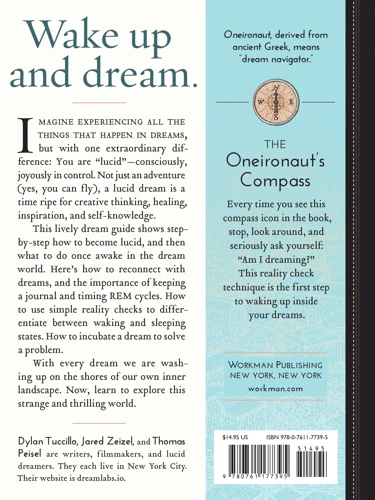Have you ever wondered what it would be like to control your dreams? To fly through the clouds or explore a hidden world all while you’re fast asleep in your bed? It may sound too good to be true, but with lucid dreaming, it’s possible. Lucid dreaming is the ability to become aware that you are dreaming and then take control of the dream. However, achieving lucidity can be difficult and requires a certain level of practice and technique. In this article, we explore five simple and effective reality check techniques that can help you achieve lucid dreaming and take control of your subconscious world.
Contents
- What is Lucid Dreaming?
- Reality Check Techniques
- When to Perform Reality Checks
- Tips for Successful Lucid Dreaming
- Conclusion
-
Frequently Asked Questions
- How often should I perform reality checks?
- What are some other methods to induce lucid dreaming?
- How long does it take to learn lucid dreaming?
- Is lucid dreaming dangerous?
- Can anyone learn lucid dreaming?
- What should I do once I realize I am dreaming?
- What are some common reality check mistakes to avoid?
- Can reality checks help with nightmare prevention?
- How can I improve my dream recall?
- Is lucid dreaming the same as astral projection?
- References
What is Lucid Dreaming?

Have you ever experienced a dream that felt so real, you could almost swear it was actually happening? What if you could take control of that dream, and shape it to your own desires and imagination? Welcome to the fascinating world of lucid dreaming – a state of consciousness where the dreamer becomes fully aware that they are dreaming, and can actively participate in, manipulate, and even direct the contents of their dream. Lucid dreaming is an art that requires practice and patience, but the rewards are endless. Let’s discover more about this incredible phenomenon, and explore the benefits and dangers, which come with it.
Benefits of Lucid Dreaming
Lucid dreaming can offer a number of benefits for those who are able to achieve it. Here are some of the most commonly reported advantages:
| Benefit | Description |
|---|---|
| Enhanced Creativity | Lucid dreaming can serve as a playground for the creative mind, allowing you to explore your imagination in ways that might not be possible in waking life. |
| Improved Problem-Solving Skills | Because lucid dreaming can help you to think more clearly, it can also aid in finding creative solutions to problems that may have been unclear or impossible in waking life. |
| Reduced Anxiety | Lucid dreaming can offer a safe space to confront and process difficult emotions and experiences, leading to a reduction in anxiety and stress. |
| Greater Self-Awareness | Through lucid dreaming, individuals can gain a deeper understanding of their inner selves, leading to personal growth and development. |
| Improved Motor Skills | Studies have shown that practicing physical activities in lucid dreams can lead to real-life motor skill improvement. |
It’s worth noting, however, that not all of the benefits of lucid dreaming are backed up by substantial scientific evidence. Some of the reported advantages may be purely anecdotal, and individual experiences may vary vastly. Nonetheless, many lucid dreamers continue to seek out the experience for the potential benefits it can offer.
Dangers of Lucid Dreaming
While lucid dreaming can be a thrilling and enjoyable experience, it is important to understand that there are potential dangers associated with this practice. Below are some of the possible risks:
- Difficulty distinguishing reality: When you spend a lot of time in a dream world, it can become challenging to differentiate between what is real and what isn’t. This can lead to confusion and disorientation in the waking world.
- Health concerns: During a lucid dream, it is possible to experience physical sensations, such as increased heart rate or breathing difficulties. These sensations, while not harmful in the dream world, could potentially cause health issues in the waking world.
- Addiction: Like any other enjoyable activity, lucid dreaming can become addictive for some people. This addiction can cause individuals to neglect their responsibilities in the waking world, leading to problems in personal and professional relationships.
- Inception: While the idea of being able to control your dream world might seem appealing, it is essential to remember that subconscious thoughts and desires can still influence your dreams. This means that you could potentially be susceptible to manipulation or even inception – the implantation of a harmful idea or suggestion in your subconscious.
- Nightmares: Lucid dreaming can be a powerful tool for overcoming nightmares, but it can also cause individuals to become stuck in a negative dream state. This can lead to a cycle of bad dreams and even cause harm to one’s mental health.
While these risks might seem alarming, they are not a reason to avoid lucid dreaming altogether. By understanding these dangers, you can take steps to mitigate them and make your lucid dreaming experience safer and more enjoyable.
Reality Check Techniques

Are you eager to take control of your dreams and unlock the endless possibilities of your subconscious mind? Lucid dreaming offers the perfect opportunity to explore the hidden corners of your imagination while asleep. However, achieving lucidity can be a daunting task for beginners. Thankfully, there are various reality check techniques that can help you distinguish between reality and a dream. These methods, when practiced regularly with patience and intention, can help you become more aware of your dream state and increase your chances of lucid dreaming. So, let’s dive into the world of reality checks and learn about the top five techniques that can help you achieve lucidity.
1. Finger Counting Reality Check
One technique for reality checking in lucid dreaming is the Finger Counting reality check. This technique can be done during the day and also during a dream. Essentially, the purpose of this technique is to test your ability to focus and accurately count your fingers.
Here is how you can do the Finger Counting reality check:
- Throughout the day, on a regular basis, stop and look at your hands.
- Count your fingers and pay attention to how many you have. Most people will have five, but some may have more or less.
- Focus on your fingers and really try to question whether you are dreaming or not.
- Look away for a few seconds and then look back at your hands.
- If the number of fingers has changed or if you have a hard time counting them, you may be dreaming. This is a signal that you can use to become lucid in your dream.
It’s important to really concentrate and question reality during this exercise. Simply going through the motions without paying close attention will not be effective in inducing lucid dreams. This reality check technique can also be combined with other checks such as the reading reality check or the digital device reality check for even stronger results.
2. Reading Reality Check
One of the most common reality checks for lucid dreamers is the reading reality check. This technique involves looking at a piece of text, looking away, and then looking back again to see if the text has changed. This is done with the hope that, in a dream, the text will change when you look back at it.
To perform this reality check, you can follow these steps:
| Step 1: | Find a piece of text to read. This could be anything from a book to a sign to a piece of writing on a wall. Make sure the text is clear and easy to read. |
| Step 2: | Read the text carefully, paying close attention to every word and letter. |
| Step 3: | Look away from the text for a few seconds. |
| Step 4: | Look back at the text and see if anything has changed. In a dream, the text may change completely or the words may become jumbled and unreadable. |
It’s important to remember that performing the reading reality check isn’t a guaranteed way to become lucid in your dreams. Some people may find that their minds are able to create readable text in their dreams, which could throw off this reality check. However, for many lucid dreamers, the reading reality check can be a helpful tool for becoming aware that they are dreaming.
Incorporating reality checks into your daily routine and being consistent with them is key to successfully using them in your dreams.
3. Digital Device Reality Check
One of the simplest and most effective techniques for performing a reality check during a lucid dream is the digital device reality check. This technique involves looking at a digital device, such as a clock, phone, or watch, and then looking away and looking back at it to see if the time has changed or if the device looks different in any way.
To perform this check, follow these steps:
| Step 1: | Get into the habit of checking the time or some other aspect of a digital device several times throughout the day. |
| Step 2: | When you perform the check during the day, be sure to look away from the device for a few moments, and then look back at it again. |
| Step 3: | During a dream, perform the same check by looking at a digital device and then looking away and looking back at it to see if anything has changed. |
The idea behind this technique is that digital devices often do not work properly in dreams, so if the time or other aspects of the device appear distorted or change unexpectedly, it is a sign that you are dreaming. By using this technique regularly throughout the day and in your dreams, you will increase your chances of recognizing that you are dreaming and becoming lucid.
It is important to note that this technique requires a certain level of awareness and focus in order to be successful. If you perform the digital device check without really paying attention, you may not notice any changes or distortions in the device, even if you are dreaming. It is important to make a conscious effort to really observe the device during the reality check.
The digital device reality check is a simple and effective technique for enhancing your lucid dreaming practice. By incorporating this technique into your daily routine and remaining focused and aware while performing it, you will increase your ability to recognize when you are dreaming and gain greater control over your dream experiences.
4. Breathing Reality Check
One of the easiest reality checks to perform is the Breathing Reality Check. In this technique, you need to analyze the way you breathe in the dream state. While dreaming, you may feel that you’re breathing underwater or can hold your breath for an extended period without any discomfort. These are signs that indicate you’re in a dream.
To perform this reality check, follow the steps below:
Step 1: Take a deep breath and hold it for a few seconds.
Step 2: While holding your breath, try to plug your nose with your fingers and see if you can breathe in or not.
Step 3: If you can breathe while blocking your nose, it means you’re dreaming, and it’s time for lucid dreaming.
This reality check helps you distinguish between reality and dream state by analyzing your breathing. From this check, you could recognize whether you are in the dream world, where the air is not a necessity.
It is essential to remain aware of your surroundings, especially when your awareness is limited in the dream world. Practicing the breathing reality check once a day takes you one step closer to the world of lucid dreaming.
5. Reflection Reality Check
Another effective technique for performing a reality check during a dream is the reflection reality check. This technique involves looking in a mirror or any reflective surface to see if your reflection matches your physical appearance in real life.
To perform the reflection reality check, you need to establish a habit of checking your reflection regularly throughout the day. You should look for specific physical features like scars, birthmarks, or tattoos to ensure that they match your appearance in real life. Once you make this habit, it can carry over to your dreams.
During a lucid dream, if you look in a mirror and your reflection does not match your physical appearance, you will know that you are dreaming. You can then take control of your dream and start exploring your desires.
However, it’s essential to mention that not all dreams feature mirrors or reflective surfaces. It’s vital to use this reality check technique in combination with others for best results.
Here’s a summary of the reflection reality check technique:
| Step 1: | Establish a habit of checking your reflection regularly during the day. |
| Step 2: | Look for specific physical features like scars, birthmarks, or tattoos to ensure they match your physical appearance. |
| Step 3: | During a dream, look in a mirror, and if your reflection doesn’t match your physical appearance, you will know you are dreaming. |
Additionally, it’s important to note that reality checks can take time to become a habit, and it may not work during the first few attempts. Don’t get discouraged and keep trying. With practice, reality checks can become second nature, leading to more frequent lucid dreams.
When to Perform Reality Checks

Performing reality checks is essential for lucid dreaming. These checks help to identify whether you are dreaming or in the waking state. It is highly recommended that you perform at least one reality check during the day. However, given the busy schedule of the modern world, it might be challenging for some to find the time and remember to perform their reality checks.
So, when should you perform your reality checks?
The best way to remember doing the checks regularly is to tie them to specific events during the day. For example, you can perform a reality check every time you go to the toilet, or every time you hear a specific word or sound. Similarly, you can perform a reality check before or after meals.
Another effective way is to set an alarm on your phone to remind you every few hours to perform your reality check. Once you get in the habit of performing the checks regularly, it will become effortless, almost second nature.
It is important to note that reality checks should not be limited to waking hours only.
You can and should do them during your dreams as well. In lucid dreaming, you can perform reality checks to determine whether you are in a dream or reality. If you find that you are dreaming, you can then proceed with lucid dreaming techniques that help you control and manipulate the dream world.
To get in the habit of performing reality checks during your dream, you can set an intention before sleep to perform them during your dreams. Some lucid dreamers even write a reminder on their hand or place it on their bedside table.
Performing reality checks is a crucial aspect of lucid dreaming. To make the most of your lucid dreaming journey, it is important to perform regular checks during waking hours and dreams. Tying reality checks to specific events during the day, setting an alarm to remind you, and setting an intention before sleep are all effective ways to incorporate reality checks into your daily routine.
Tips for Successful Lucid Dreaming
One of the main keys to successful lucid dreaming is consistency. Making an effort to consistently practice reality checks and other lucid dreaming techniques can greatly increase your chances of having lucid dreams. Here are a few tips that can help you achieve successful lucid dreaming:
Maintain a Dream Journal: Keeping a dream journal helps you track and remember your dreams. This is important because it can help you identify any patterns or recurring themes in your dreams. Additionally, writing down your dreams can help you become more aware of the details and can eventually lead to a better understanding of when you are dreaming.
Set Your Intention: Before you go to sleep, set your intention to have a lucid dream. You can repeat a mantra or even visualize yourself having a lucid dream. This helps to program your subconscious mind to become more aware during your dreams.
Practice Reality Checks: As mentioned earlier, practicing reality checks during the day can greatly improve your chances of having lucid dreams. Make sure to choose a reality check that you feel comfortable with and practice it consistently throughout the day.
Use Affirmations: Affirmations are positive statements that can help reinforce your intention to have a lucid dream. Repeating phrases such as “I am aware I am dreaming” or “I can control my dreams” can help to program your subconscious mind.
Avoid Stimulants: Avoiding stimulants such as caffeine and alcohol can help improve the quality of your sleep, making it easier to have lucid dreams.
Experiment: Finally, don’t be afraid to experiment with different lucid dreaming techniques. Every person is different and what works for one person may not work for another. So, remain open to trying new things and remember that it takes time and practice to achieve successful lucid dreaming.
Conclusion
In conclusion, lucid dreaming can be a truly fascinating and beneficial experience if practiced with caution and discipline. By using reality check techniques such as finger counting, reading, digital devices, breathing, and reflection, individuals can train their minds to recognize when they are in a dream state, allowing them to take control of their dreams and explore new realities. However, it’s important to remember the potential dangers of lucid dreaming, such as sleep paralysis and issues with reality perception. Therefore, it’s crucial to practice lucid dreaming with care and respect for the powerful forces it can unleash.
To increase the likelihood of successful lucid dreaming, individuals should make sure to perform reality checks multiple times a day, particularly during moments of heightened awareness or confusion. By using these checks as a way to engage with the world and examine its details, individuals can train their minds to question reality and sharpen their perception. In addition, it’s important to maintain good sleep hygiene, create a relaxing sleep environment, and establish a consistent bedtime routine to promote healthy and restful sleep.
Ultimately, lucid dreaming can be a powerful tool for self-discovery and exploration, allowing individuals to challenge their perceptions and push the boundaries of their own consciousness. With patience, discipline, and a sense of wonder, anyone can learn to enter the world of lucid dreams and discover the endless possibilities that lie within. So, embrace the wonder of lucid dreaming, but always remember to proceed with caution and respect for the power it can hold.
Frequently Asked Questions
How often should I perform reality checks?
You should perform reality checks frequently throughout the day, at least 10 times a day, to increase your chances of having a lucid dream.
What are some other methods to induce lucid dreaming?
Other methods include keeping a dream journal, practicing meditation, and using supplements such as melatonin or galantamine.
How long does it take to learn lucid dreaming?
The time it takes to learn lucid dreaming varies from person to person, but with consistent practice and dedication, it is possible to achieve lucid dreaming within a few weeks to a few months.
Is lucid dreaming dangerous?
Lucid dreaming is generally considered safe, but it is important to be aware of the potential risks of sleep paralysis and false awakenings.
Can anyone learn lucid dreaming?
Yes, anyone can learn lucid dreaming with practice and dedication, although some individuals may find it easier to achieve than others.
What should I do once I realize I am dreaming?
Once you realize you are dreaming, you can try to maintain your lucidity by staying calm and focused, and engaging with your dream environment in a controlled manner.
What are some common reality check mistakes to avoid?
Some common mistakes include performing reality checks absentmindedly, relying solely on one technique, and failing to question reality with curiosity.
Can reality checks help with nightmare prevention?
Yes, reality checks can also be used to prevent nightmares by helping you recognize when you are dreaming, and allowing you to take control of the dream environment.
How can I improve my dream recall?
You can improve your dream recall by keeping a dream journal, practicing mindful awareness throughout the day, and getting enough quality sleep.
Is lucid dreaming the same as astral projection?
No, lucid dreaming and astral projection are two separate experiences. Lucid dreaming involves being aware and in control of your dream environment, while astral projection involves an out of body experience where you are believed to leave your physical body entirely.







